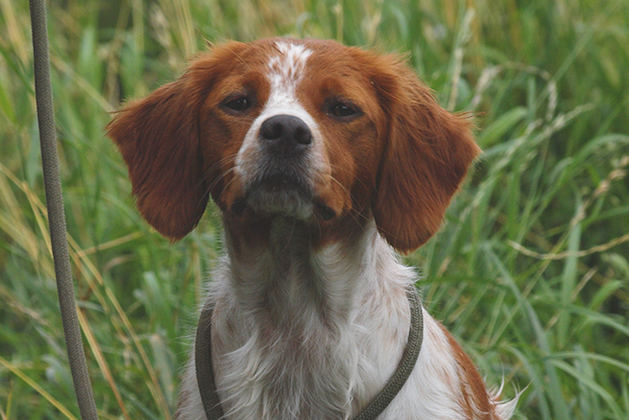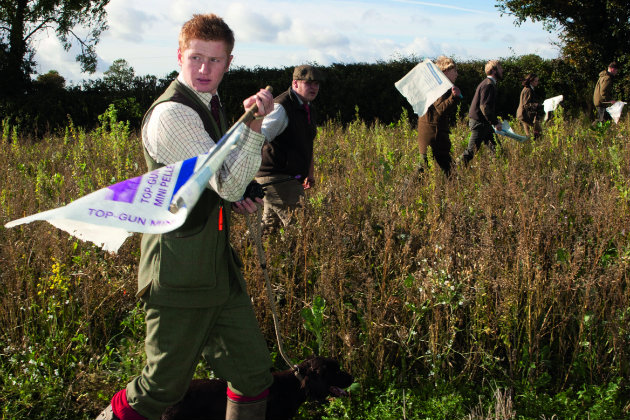What’s the best beating dog?
Beating dogs are the forgotten heroes of the shooting world. They far outnumber all the picking-up dogs and peg dogs…
Win CENS ProFlex DX5 earplugs worth £1,149 – enter here
Paul Rawlings shows you how to ensure you have the best gundogs on the beating line

First, when you are asked to go beating and the keeper says, “bring your dog if you like,” make sure you find out what type of shoot it is and what your dog will be expected to do. Then think carefully whether your dog is suitable and whether it is sufficiently trained and under your control. When you are out on a shoot for the first time, err on the cautious side until you have gained local knowledge about the terrain.
The first shoot I took my Labrador on had a mixture of arable land with huge fields of sugar beet, and the Guns would be positioned at one end with perhaps walking Guns on each flank. It was usual for all game to be retrieved as it was shot so my dog had lots of chances. However it became something of a free-for all with the winning dog the fastest. In retrospect I should not have taken my Labrador because it spoiled her steadiness – something to consider when you take your dog into a beating line with walking Guns, or where game is being shot in full view.

Putting a slip lead on your dog at key points will keep it under control
As the season drew on, we then began pushing the game from the open ground into the woodland coverts where all the reared birds had been released. The density of game was high as we approached the flushing points with hundreds of birds packed together at the end of the main coverts. The keeper would tell us to get our dogs to heel once we neared the end, but often that was too late and some of the older dogs would pull forward and a multi-flush of birds would result.
I soon learned to slip a lead over my dog’s head well before the order from the keeper came. If your dog is under control then it cannot get into trouble and a lead is the safest option in the densest cover. With more knowledge of the drives I was able to make sure that I had my dog back at heel well before we reached the danger points.
Although my spaniel was very obedient during training she soon realised that she could misbehave when hunting in front of the beating line where I couldn’t see her. She used to turn on two pips of the whistle, but with everyone blowing a whistle trying to control their own dogs, and with the shouting, tapping and waving, she soon switched off her ears and her prey drive took over.
The problem is that I had never trained her in company although she had a fantastic natural talent. She wasn’t used to the cracking of flags and had never been among high densities of game. So make sure you introduce your dog to these things before you take them out beating.

Make sure your dog is used to the cracking of flags on the beating line
Wind direction plays an important part when driving birds towards the waiting Guns. The keeper will be aware of this and the Guns’ pegs will be located to the best advantage, so that shooting is enjoyed by all of them. This often means that dogs will be working downwind for much of the time.
On a downwind beat the dog should pull out and then quarter back towards you, and only once that ground has been covered should you move forward to a fresh piece. Of course, in the beating line it is not possible for you to pause while your dog works the wind and therefore the dog is encouraged to keep pulling forward, tracking game.
This will quickly ruin a dog’s pattern, and instead it will be taught inadvertently to “pull” with the result that ground will not be covered properly and game will be passed. Don’t allow your dog to pull downwind — bring it back to heel and only let it hunt when you can keep control.
When introducing a new dog to the shoot I used to volunteer to blank-in any ditches or rough cover into the main beat. This gave me a chance to make sure they were under full control before the main beating line pushed forward in earnest.
Beating dogs are the forgotten heroes of the shooting world. They far outnumber all the picking-up dogs and peg dogs…
Essential advice for beaters on a shoot day
Terriers are an asset in the beating line, says David Bezzant after observing a Jack Russell at work on a…
Get the latest news delivered direct to your door
Discover the ultimate companion for field sports enthusiasts with Shooting Times & Country Magazine, the UK’s leading weekly publication that has been at the forefront of shooting culture since 1882. Subscribers gain access to expert tips, comprehensive gear reviews, seasonal advice and a vibrant community of like-minded shooters.
Save on shop price when you subscribe with weekly issues featuring in-depth articles on gundog training, exclusive member offers and access to the digital back issue library. A Shooting Times & Country subscription is more than a magazine, don’t just read about the countryside; immerse yourself in its most authoritative and engaging publication.

